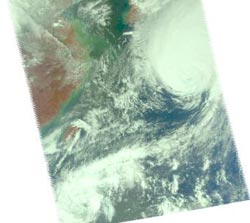Typhoon Melor and Tropical Storm Parma mean double trouble in the western Pacific

NASA\'s Aqua satellite captured this visible image of Tropical Storm Parma (lower left) and Typhoon Melor (top right) on Oct. 7. Credit: NASA JPL, Ed Olsen<br>
There's double-trouble in the Western Pacific with one typhoon and one tropical storm bringing soaking rains, dangerous surf and gusty winds to two different locations. Typhoon Melor is affecting the east coast of Japan and watches and warnings are up today. Further south, Tropical Storm Parma continues to rain on Luzon in the northern Philippines.
Typhoon Melor is currently affecting southern Japan and bringing gusty winds, heavy rains and high waves there. High Wave and Gale Watches and warnings have been posted in Japan in the prefectures of Miyazaki and Kagoshima today.
At 11 a.m. EDT, Typhoon Melor had sustained winds near 75 knots (86 mph). It was located 350 nautical miles southwest of Tokyo, Japan, near 32.7 North and 135.4 East. Melor is moving northeast near 25 knots (28 mph) and is generating 30-foot high waves. At 11 a.m. EDT, the storm was almost due south of the city of Wakayama.
Melor is currently becoming extra-tropical as it approaches Honshu. It will accelerate northeast to the west of Tokyo and reemerge over the Pacific as a strong non-tropical low pressure system.
At 11 a.m. EDT on October 7, Parma had been downgraded to a tropical storm with sustained winds near 35 knots (42 mph). Parma was located 225 nautical miles north-northeast of Manila, Philippines, near 18.1 North and 122.4 East. Parma has tracked north-northeastward at 4 mph. Parma is still generating waves up to 22 feet high.
Parma's forecast track is still somewhat questionable, as different computer forecast models take Parma on different tracks. However, forecasters at the U.S. Navy's Joint Typhoon Warning Center are forecasting Parma to slowly crawl from northeastern Luzon back across the northern island and finally into the South China Sea sometime on October 9. The slow movement across the northern Philippines means more unwelcome rain in the region over the next several days.
Warnings are posted in the Philippines today. Public storm warning signal 1 is in force in Batanes Group of Islands, Cagayan, Babuyan Island, Calayan Island, Ilocos Norte & Sur, Apayao, Abra, Kalinga, Mountain Province, Isabela, Ifugao, Nueva Vizcaya, Northern Aurora and Benguet.
An instrument on NASA's Aqua satellite captured both typhoons in one image. The Atmospheric Infrared Sounder (AIRS) captured both Parma and Melor in a visible and infrared image October 7 at 0453 UTC (12:53 a.m. EDT) as Parma continues to rain on northern Luzon in the Philippines, while Melor is now bringing rains and winds over southern Japan.
The infrared imagery revealed that the cloud tops of Parma are not as cold as they are in Melor, indicating that Parma is a much weaker storm. Typhoon Melor has some strong thunderstorms, where temperatures are colder than -63 Fahrenheit.
Infrared imagery has also shown that Tropical Storm Parma has made its track over Luzon, and is now back over the open waters of the Philippine Sea. Although Parma's track over land weakened the storm, the open waters are expected to power the storm's convection and thunderstorms back up. In fact, infrared imagery has shown that convection is already redeveloping near the low level center of the storm.
Media Contact
More Information:
http://www.nasa.govAll latest news from the category: Earth Sciences
Earth Sciences (also referred to as Geosciences), which deals with basic issues surrounding our planet, plays a vital role in the area of energy and raw materials supply.
Earth Sciences comprises subjects such as geology, geography, geological informatics, paleontology, mineralogy, petrography, crystallography, geophysics, geodesy, glaciology, cartography, photogrammetry, meteorology and seismology, early-warning systems, earthquake research and polar research.
Newest articles

High-energy-density aqueous battery based on halogen multi-electron transfer
Traditional non-aqueous lithium-ion batteries have a high energy density, but their safety is compromised due to the flammable organic electrolytes they utilize. Aqueous batteries use water as the solvent for…

First-ever combined heart pump and pig kidney transplant
…gives new hope to patient with terminal illness. Surgeons at NYU Langone Health performed the first-ever combined mechanical heart pump and gene-edited pig kidney transplant surgery in a 54-year-old woman…

Biophysics: Testing how well biomarkers work
LMU researchers have developed a method to determine how reliably target proteins can be labeled using super-resolution fluorescence microscopy. Modern microscopy techniques make it possible to examine the inner workings…





















